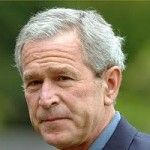Last week, in response to a new level of saber-rattling by North Korea, Defense Secretary Chuck Hagel announced that the US would add 14 interceptors to the US anti-missile base at Fort Greely, Alaska; part of a missile defense network in the west that protects the United States from rogue missile attack.
The announcement was a veiled warning to the North Korean regime as it ratchets up its nuclear threats, as well as a form of reassurance to Americans in Hawaii and the West Coast, that the nation has the ability to defeat a limited missile attack on American territory.
Simply put, thank goodness we have it.
Thank goodness that we are not now doubling down on some crash program designed to have some system in place in a few years.
Thank goodness that in this instance at least, our leaders of the past thought ahead.
Thank goodness for George W. Bush.
Speaking before the Republican National Convention on August 3, 2000, then-Governor Bush said, “I will work to reduce nuclear weapons and nuclear tension in the world…And, at the earliest possible date, my administration will deploy missile defenses to guard against attack and blackmail.”
True to his word, on July 22nd 2004, the 1st missile interceptor was installed at Ft. Greely Alaska. 15 more would be deployed by the end of 2005, forming the basis for the system that guards the US today.
But deployment of missile defenses was not without controversy, nor was it without opponents – uniformly Democrats.
Now-former Senator Jeff Bingaman said this in May 2001, “However, his [President Bush’s] prescription for how best to ensure our national security and achieve a more peaceful world is seriously flawed. The President has assigned the nation’s highest military priority to building a robust missile defense that will cost tens of billions of dollars during the coming decade with no assurance that the system of interceptors will work. The primary objective of such a system, in his view, is to counteract intercontinental missiles carrying weapons of mass destruction from targeting our nation. I would urge the President to take a step back…”
Democratic House member from Massachusetts, John Tierney said this during a debate on missile defense in June 2001:
The alleged purpose of this limited national missile defense or the early stages of the Bush administration plan is supposedly to protect us against rogue nations or against accidental or unintended launches. Rogue nation threats are primarily the national missile defense concern, or so we are told. If that is the case, we should access them and
assess them on whether or not that threat of missiles from rogue nations compares to other threats that exist to our Nation.”
Representative Tierney is still in Congress, representing the 6th District. Perhaps someone should ask him about the “so-called” threat from North Korea, and whether the Member supports the Administration’s response.
And then there is President Obama.
The order to beef up West coast missile defenses either originated or was approved by the President. That order was prudent and responsible and fully consistent with a serious Commander in Chief. But that is also today.
In October 2007, as a candidate for the presidency, then-Senator Obama said, “I will cut investments in unproven missile defense systems.” Instead, the would-be Commander-in-Chief signaled his preference for international negotiations on nuclear weapons and radically lower warhead thresholds as an alternative to missile defense technology. Indeed, the first steps by the Obama administration clipped the wings of the anti-missile defense program as it related to coverage for the East coast.
The quotations from Democrats in opposition to the program could fill volumes.
Indeed, from President Reagan’s announcement regarding a Strategic Defense Initiative (SDI) in 1983, through the evolution of the program into a more limited and specific missile defense system focused on rogue states, in place today, Democrats have consistently opposed missile defense. As Powerlineblog points out, “Virtually all Democrats opposed all forms of missile defense, deeming the concept not only unfeasible–”like hitting a bullet with a bullet,” as though that were impossible–but destabilizing as well.” Powerline also points out – ironically, that John Kerry’s denunciations of missile defense were typical, “a dream based on illusion, but one which could have real and terrible consequences.”
Does our new Secretary of State feel the same way today?
This matters because the argument is not academic – it is terrifyingly real.
Almost 50 million Americans live in Alaska, Hawaii and the American West Coast. Even a most unsophisticated North Korean missile, jury-rigged to fly the distance and aimed generally in the direction of the US, carrying a primitive low-yield nuclear warhead, could cause untold physical and environmental devastation.
The Democratic position has been to say that the best way to address these concerns were with agreements, not defensive systems.
That position is both flawed and now failed.
The nation owes a profound debt of gratitude to George W. Bush who saw beyond the tired debates of the moment and remained steadfast in his plans to secure the American people in the future.
It is the irony of politics that those who today benefit the most from Bush’s foresight are also those who live in states that were happiest to see him go.

